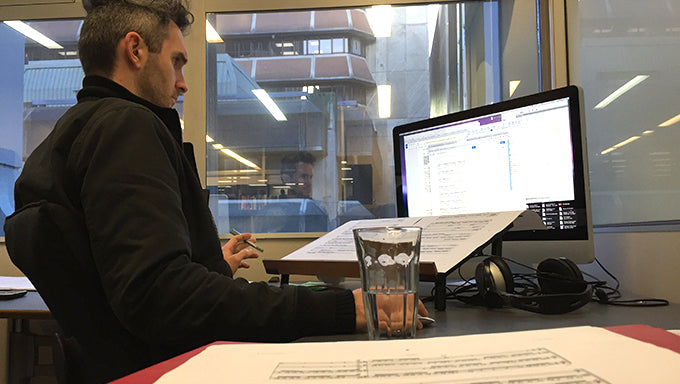
Haere rā (farewell) Brad
Share
After nine years of dedicated service we say haere rā (farewell) to Brad Jenkins. We will sure miss you Brad!

Brad and Ross at brunch, January 2017.
Brad joined Promethean Editions in mid-2013 and was soon thrust into the task of helping us move offices, from The Terrace to Boulcott Street. We probably should have put ‘office moving’ on the job description, as we would later have to move three more times in as many years. Brad’s first two editorial projects were Christos Hatzis’ String Quartet No.1 (PE117) and String Quartet No.2 (PE107), not the easiest of works to cut your teeth on, when also learning a new software.
After that baptism by fire, Brad typeset Douglas Lilburn's Drysdale Overture (PEL21) from a handwritten manuscript, which was the first volume in the Lilburn Centenary Edition. Brad then went on to complete all the typesetting work in that series of four orchestral works as well as a set of songs, with editorial oversight from Rod Biss, Robert Hoskins and myself.

The score of Christos Hatzis String Quartet No.2 ‘The Gathering’.
It became clear early on that Brad’s ability to write eloquently, and creatively, about music far exceeded my own capabilities. So, the writing of text for all publications became part of Brad’s job. This expanded over the years, to cover writing all new blurbs for all published and unpublished works in the catalogue, as can be seen across our website and webstore, and his writing features in all publications from 2013 through 2022.
Brad was the music editor for some notable smaller scale works, including a pair of Hatzis violin works written for Hilary Hahn, Coming To (PE119) and Dystopia (PE121). He also completed our first publications for brass band, Onslaught and The Nor’West Arch by Gareth Farr. This brass band knowledge would come in handy later, when he took charge of the scholarly level work required for Volume 8 of the Larry Pruden Collected Edition: Works for Brass Band and Wind Ensemble (PEP08).

The score and part for Coming To by Christos Hatzis, written for Hilary Hahn.
Brad also played a large role in the University Music Edition | New Zealand Series, editing a majority of those publications released during his time here. This included four of Anthony Ritchie symphonies, one of which is the largest item in our published catalogue, Symphony No.5 (UME19) weighing in at 206 pages. Amongst all the publications and text origination, there was untold amounts of proofing of my publication projects, as well as proofing of orchestral sets for many new works, including Hatzis’ music for the ballet Going Home Star: Truth and Reconciliation, for which the total page count of score plus parts was 1120.

The purple-covered University Music Edition | New Zealand Series publications edited by Brad.
Brad writes:
Well, after nine years it's finally time for me to add the final bar line to my time with Promethean Editions. When I started out with Promethean as a Music Editor I was working towards a Masters in Composition at Wellington’s Victoria University. By that time I'd spent a few years tinkering with Sibelius as part of my studies and I thought I knew a thing or two about the art of engraving and bending notation software to my will. But I quickly learned that I was still very much a student of the game.
With Ben and Ross showing me the way, I explored the deeper, lesser known menus of Sibelius and Finale – those that allow you to control the appearance of any musical element. I learned how efficient the engraving process could be if you knew how to use the tools at your disposal.
Any successful editorial process is designed with efficiency in mind, and as I internalised the editorial process that underpins Promethean's distinctive House style, I grew to understand the rationale behind the detailed sequence of proofing and standardising required to get our scores looking as good as possible while also offering maximum practicality for the performer. We generally work from the middle of the stave outward, checking rhythms and pitches first and working our way out of the stave to dynamics, hairpins, expressions and tempos.
One of my favourite brands of endorphin hit as an engraver was arriving at an “elegant solution” for the notation of a passage of music that included an extended technique of some description, especially if it improved on how the composer had notated it in their original manuscript.

Volume 8 of the Larry Pruden Collected Editions: Music for Brass Band and Wind Ensemble.
My personal favourite landmark in the editorial process was the transition from “scroll view” to “page view” where, after seemingly endless standardising, you were able to begin organising the measures of a score page by page. This is when the music first begins to look like an actual score and you begin to see the promise of the finished product on the horizon. This excitement was often tempered by the frustration and indecision that comes with the horizontal spacing of measures on a page, as you strive for a uniform spacing across the entire score. I amazed myself with how long I could sit in front of a screen, moving a single measure on and off the end of a page spread before reaching a decision (only for Ross or Ben to suggest I change it back).
The Music Editor role also hammered home the importance of the proofing stage – namely, having another pair of eyes scan your work. As someone with a strong eye for detail (I can spot a typo at 50 paces), this was the most humbling aspect of the job. The particular blend of surprise, confusion and humility you feel when your colleague hands you their marked-up proofreading of your score’s first draft layout and points out a wrong note in the very first measure (the measure you’ve probably looked at the most over the past few weeks) is something unique to music engraving.

Brad proofing parts for Hatzis' music for the ballet Going Home Star: Truth and Reconciliation, March 2015.
The final learning I'll mention is on the importance of promotion. The promotion game is neverending. For all the work that goes into Promethean’s world-class publications, a whole lot of work also goes into introducing our catalogue of contemporary music to performers, institutions and audiences in Aotearoa and the rest of the world. It's a big job, but Promethean Editions is in good hands. It has been a privilege to work with some of the best minds in the composing and engraving worlds. Thanks for the memories!

